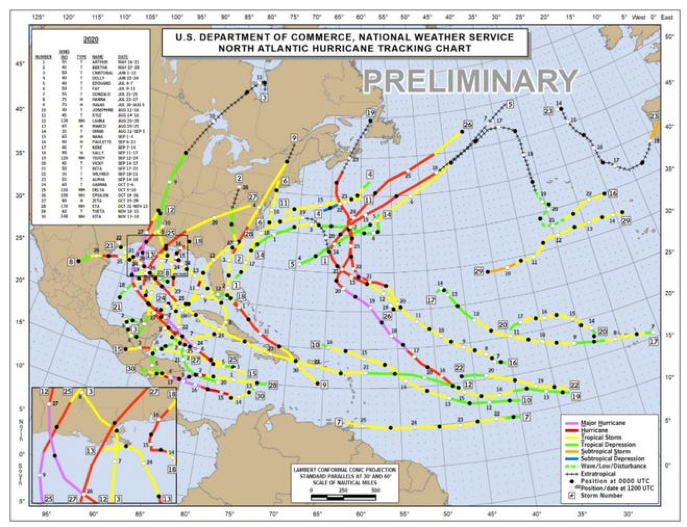Here where I live in South Florida, the first storm of the year stirs conversations that center on questions like, “Isn’t this year’s storm season starting earlier than normal?” and “Is this because of climate change?” and “Are storms getting worse?” The answers cause confusion because the data, at the moment, provide different answers to each of those questions.
Are we getting storms earlier each year?
2020 was a hurricane season for the record books. And there have been five named storms so far this year, beating the record set last year.

Named storms in 2020 (US Commerce Department)
Hurricane season officially starts June 1, but it is not all that unusual to see storms arrive before then.
In truth, “pre-season” storms occur every five years, so we should perhaps reconsider what we consider to be the “season.” In fact, it is a serious discussion that could result in moving the official start of the hurricane season to mid-May in the future.
[the_ad id=”667826″]
Are we getting more hurricanes than we used to?
The answer to this may surprise you. The federal Climate.gov website, part of the National Oceanic and Atmospheric Administration, says, “Most climate model studies project the total number of TCs each year to decrease or remain approximately the same.”
One of the great curiosities is why there was a sustained hurricane drought from 2005 to Hurricane Harvey that came ashore in 2017. There are many factors in this discussion. The determination of what qualifies as a major hurricane changed over the years, and some damaging storms were not officially hurricanes. Sandy, for example, was a post-tropical cyclone when it washed into New York.
Climate experts say that we do not have enough high-quality climate data to make definitive statements yet about the cause-and-effect facts related to climate change and hurricane frequency.
Are storms getting more severe?
This answer is yes, and the reason is connected to a rising sea surface temperature. Remember, warm water feeds storms. NOAA has suggested that an increase in Category 4 and 5 hurricanes is likely, with hurricane wind speeds increasing by up to 10%. It is a global trend, too.
Hurricanes are getting wetter, too. Hurricanes Harvey, Florence and Imelda are examples of that. NOAA puts it this way:
Warming of the surface ocean from anthropogenic (human-induced) climate change is likely fueling more powerful Tropical Cyclones. The destructive power of individual TCs through flooding is amplified by rising sea level, which very likely has a substantial contribution at the global scale from anthropogenic climate change. In addition, TC precipitation rates are projected to increase due to enhanced atmospheric moisture associated with anthropogenic global warming.
Yale researchers explained it in clear terms saying, yes, storms are intensifying and, while it might be part of a normal cycle, human-caused climate change may also be a factor. They say this because they cannot find anything in historic records that mimics what they see in the data today. In short, this is not a settled matter, except that storms are getting stronger.
[the_ad id=”667872″]
Are storm zones changing northward?
A firm “maybe” on this question is in order. The movement of tropical cyclones seems to be changing. They are more likely to move forward more slowly, which gives them time to gather strength and cause more damage when they pass over land.
And the locations of storms seem to be shifting. Jim Kossin, an atmospheric scientist with NOAA’s National Climatic Data Center, analyzed historical records of storms and documented that on average, the latitude where tropical cyclones reach their peak strength has shifted farther north of the equator in the Northern Hemisphere:
The shifts in where storms form and reach maximum intensity are particularly bad news for the United States and Japan.
This article originally appeared in Covering COVID-19, a daily Poynter briefing of story ideas about the coronavirus and other timely topics for journalists. Sign up here to have it delivered to your inbox every weekday morning.
[the_ad id=”667878″]










